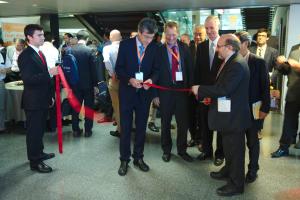The Spanish contribution to ITER
24 Sep 2013
-
Belén del Cerro Gordo, ITER Liaison Officer
Opening the floor to the ISFNT Industrial Exhibition: Chairman Joaquin Sanchez (CIEMAT director); Fusion for Energy Director Henrik Bindslev; ITER Director-General Osamu Motojima; Vice-Consul of Netherlands in Barcelona Dirk Kremer; Hideyuki Takatsu, part of the ISFNT steering committee and ITER Council Chair; and Pere Torres, Secretary of Enterprise and Competitiveness for the Generalitat de Catalunya.
Spain's relationship with ITER is especially close as the city of Barcelona hosts the European agency Fusion for Energy, which manages the European contribution to the project.
Spanish research centres—led by CIEMAT and in cooperation with other European partners—play a crucial role in ITER by contributing to the development of diagnostic systems, plasma heating components, test blanket modules, and control and data acquisition systems.
The Centre for the Industrial and Technological Development (CDTI) promotes the participation of Spanish industry and acts as a focal point between companies and ITER. For Spanish industry, ITER is a unique opportunity to develop cutting-edge technologies, but also an occasion to foster commercial products in industrial areas outside fusion energy. This cross-fertilization will contribute to the scientific and technological progress in the coming decades.
Since 2008, Spanish companies have earned an increasing number of contracts for ITER, with a peak in 2012. According to the latest estimates, Spanish industry has won over EUR 400 million in contracts in a highly competitive market, with many opportunities for participation ongoing. Spanish industrial capabilities cover a wide range of technological areas, making it possible to participate in the fabrication of many ITER components such as the vacuum vessel, magnets, buildings, test blankets modules, plant systems, in-vessel components, remote handling, safety, instrumentation and control and CODAC, to name but a few.
Spanish companies have also won important contracts in other fusion facilities such as the European tokamak JET, TJ-II (CIEMAT) and W7X (Germany) and have taken on significant challenges in the supply of components for the Spanish in-kind contributions to the Broader Approach projects IFMIF-EVEDA and JT-60.
Many of the developments for ITER and fusion projects have been made in collaboration with other European industries either through consortia or through the supplier chain, showing that the effort for fusion is really framed inside a wide European dimension.


